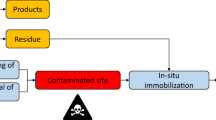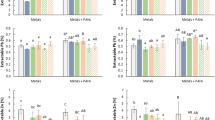Abstract
The ability of standard soils to capture heavy metals or polycyclic aromatic hydrocarbons (PAHs) from ammoniacal copper zinc arsenate (ACZA)– or creosote-treated wood, respectively, was assessed using pressure-treated posts immersed in a freshwater pond. The soil, in heat-sealed, permeable plastic mesh sachets, was able to intercept copper, zinc, arsenic, and PAHs migrating from the posts. Chemical levels were much higher immediately adjacent to the posts and declined with distance from the posts. Metals were consistently detected around ACZA-treated posts, while 10 of the 16 EPA priority pollutants were detected in at least one sachet embedded around creosote-treated posts at each sampling point. These results were consistent with traditional sediment sampling methods. The primary advantages of the sachets were their consistency in terms of soil characteristics and the ease with which they could be retrieved from the pond. Further studies are planned to better understand the role of soil characteristics in the sachets on the ability to capture migrating preservatives.

Similar content being viewed by others
References
American Wood Protection Association (AWPA) (2017) Book of standards. AWPA, Birmingham 644 p
Anastassiades M, Lehotay SJ, Štajnbaher D, Schenck FJ (2003) Fast and easy multiresidue method employing acetonitrile extraction/partitioning and “dispersive solid-phase extraction” for the determination of pesticide residues in produce. J AOAC Int 86(2):412–431
Brooks KM (2011) Chapter 5. Fate and effects of contaminant released into aquatic environments. In: Morrell JJ, Brooks KM, Davis CM (eds) Managing treated wood in aquatic environments. Forest Prod Soc, Madison, pp 59–152
Cooper PA (1991) Cation exchange adsorption of copper on wood. Wood Pro 1(1):9–14
Dahlgren SE, Hartford WH (1972a) Kinetics and mechanism of fixation of Cu-Cr-As wood preservatives. Part I. pH behaviour and general aspects of fixation. Holzforschung 26(6):62–69
Dahlgren SE, Hartford WH (1972b) Kinetics and mechanism of fixation of Cu-Cr-As wood preservatives. Part II. Fixation of Boliden K33. Holzforschung 26(6):105–112
Forsberg ND, Wilson GR, Anderson KA (2011) Determination of parent and substituted polycyclic aromatic hydrocarbons in high-fat salmon using a modified QuEChERS extraction, dispersive SPE and GC-MS. J Agric Food Chem 59:8108–8116
Hunt GM, Garratt GA (1967) Wood preservation, 3rd edn. McGraw-Hill, New York
Jin L, Archer K (1991) Copper based wood preservatives: observations on fixation, distribution and performance. Pro Am Wood-Preservers’ Assoc:169–184
Kang SM, Morrell JJ, Simonsen J, Lebow ST (2003) Creosote movement from treated wood immersed in fresh water: initial PAH migration. International Research Group on Wood Preservation Document No. IRG/WP/03-50201, Stockholm
Kang SM, Morrell JJ, Simonsen J, Lebow S (2005) Creosote movement from treated wood immersed in fresh water. Forest Prod J 55(12):42–46
Lebow ST (1996) Leaching of wood preservative components and their mobility in the environment-summary of pertinent literature. Gen. Tech. Rep. FPL-GTR-93. U.S. Department of Agriculture, Forest Service, Forest Products Laboratory, Madison, p 36
Lebow ST, Morrell JJ (1995) Interactions of ammoniacal copper and zinc arsenate (ACZA) with Douglas-fir. Wood Fiber Sci 27(2):105–118
Martinez E, Gros M, Lacorte S, Barcelo D (2004) Simplified procedures for the analysis of polycyclic aromatic hydrocarbons in water, sediments, and mussels. J Chromatogr A 1047:181–188
Morrell JJ, Chen H (2008) Migration of pentachlorophenol from treated poles in storage and its mitigation. In: Proceedings, International Conference on Overhead Lines. Fort Collins, Colorado, pp 445–455
Morrell JJ, Keefe D, Baileys RT (2003) Copper, zinc, and arsenic in soil surrounding Douglas-fir poles treated with ammoniacal copper zinc arsenate (ACZA). J. Environ Qual 32:2095–2099
Morrell JJ, Love CS, Freitag C (2010) Metal migration from Douglas-fir poles treated with ammoniacal copper zinc arsenate according to best management practices. Document No IRG/WP/10-50272. International Research Group on Wood Protection, Stockholm, p 14
Pizzi A (1981) The chemistry and kinetic behaviour of Cu- Cr-As/B wood preservatives. I. Fixation of chromium on wood. J Polym Sci Chem 19:3093–3121
Pizzi A (1982) The chemistry and kinetic behaviour of Cu- Cr-As/B wood preservatives. II. Fixation of the Cu/Cr system on wood. III. Fixation of a Cr/AS system on wood. IV. Fixation of CCA to wood. J Polym Sci Chem 20:707–764
Rhatigan R, Morrell JJ (2000) Preservative movement from Douglas-fir decking and timbers treated with ammoniacal copper zinc arsenate using best management practices. Forest Prod J 50(2):54–58
Ruddick JNR (1996) The fixation chemistry of copper in basic preservative systems. In: Proceedings, American Wood Preservers’ Association, vol 92, pp 32–49
Ruddick JNR (2003) Basic copper wood preservatives, preservative depletion: factors which influence loss. Proc Can Wood Preserv Assoc 24:26–59
Stilwell DE, Graetz TJ (2001) Copper, chromium and arsenic levels in soil near traffic sound barriers built using CCA pressure-treated wood. Bull Environ Contam Toxicol 67:303–308
Stilwell DE, Korny KD (1997) Contamination of soil with copper, chromium and arsenic under decks built from pressure treated wood. Bull Environ Contam Toxicol 58:22–29
Wendt PH, Van Dolah RF, Bobo MY, Mathews TD, Levisen MV (1996) Wood preservative leachates from docks in an estuarine environment. Arch Environ Contam Toxicol 31:24–37
Western Wood Preservers Institute (2012) Best management practices for the use of treated wood in aquatic or wetland environments. WWPI, Vancouver 36 p
Ye M, Morrell JJ (2015) Effect of post-treatment processing on copper migration from Douglas-fir lumber treated with ammoniacal copper zinc arsenate. J. Environ Manage 152:268–272
Zabel RA, Morrell JJ (1992) Wood microbiology: decay and its prevention. Academic Press, San Diego
Acknowledgments
This research was supported by the Oregon State University Environmental Performance of Treated Wood Research Cooperative (www.oregonstate.edu/cof/coops).
Author information
Authors and Affiliations
Corresponding author
Additional information
Responsible editor: Zhihong Xu
Publisher’s note
Springer Nature remains neutral with regard to jurisdictional claims in published maps and institutional affiliations.
Rights and permissions
About this article
Cite this article
Konkler, M.J., Morrell, J.J. Assessment of preservative migration from wood using a soil sachet method. Environ Sci Pollut Res 26, 19598–19605 (2019). https://doi.org/10.1007/s11356-019-05289-6
Received:
Accepted:
Published:
Issue Date:
DOI: https://doi.org/10.1007/s11356-019-05289-6




